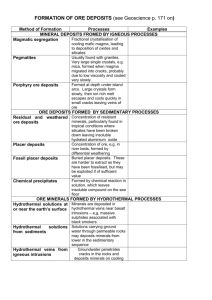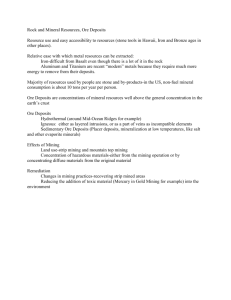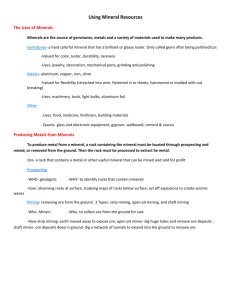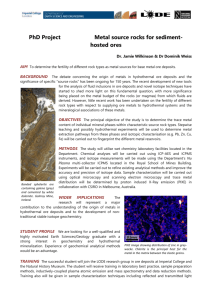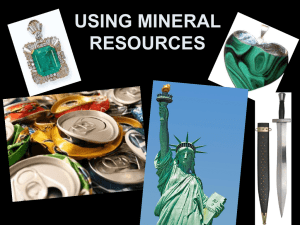sulfates
advertisement
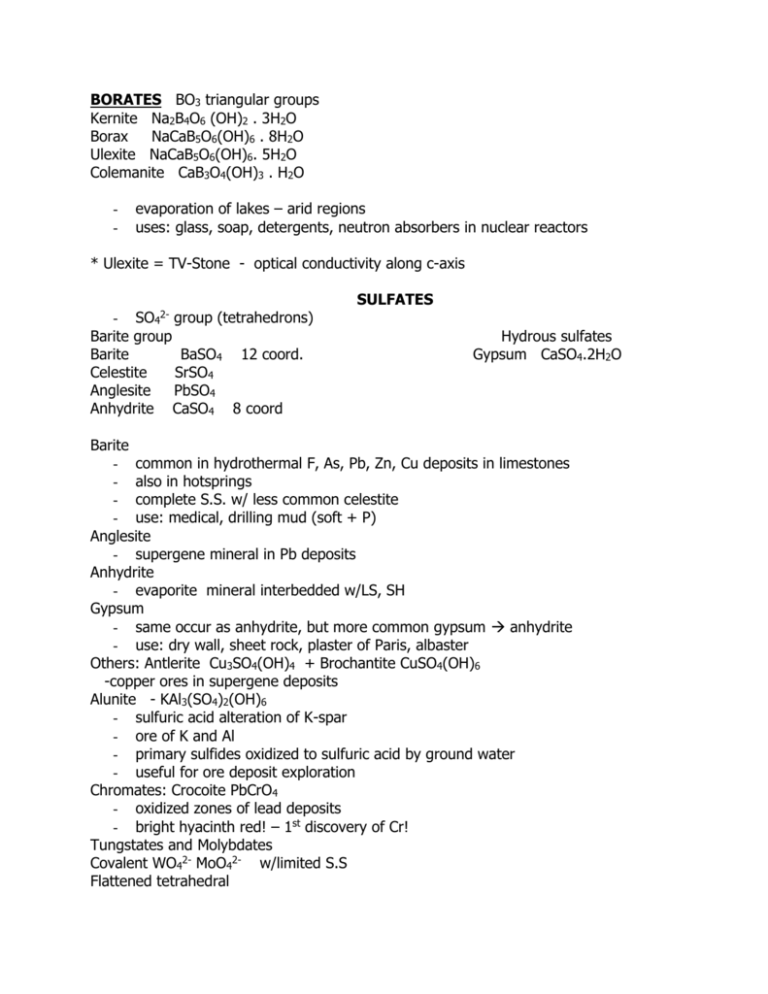
BORATES BO3 triangular groups Kernite Na2B4O6 (OH)2 . 3H2O Borax NaCaB5O6(OH)6 . 8H2O Ulexite NaCaB5O6(OH)6. 5H2O Colemanite CaB3O4(OH)3 . H2O - evaporation of lakes – arid regions uses: glass, soap, detergents, neutron absorbers in nuclear reactors * Ulexite = TV-Stone - optical conductivity along c-axis SO42- group (tetrahedrons) Barite group Barite BaSO4 12 coord. Celestite SrSO4 Anglesite PbSO4 Anhydrite CaSO4 8 coord SULFATES Hydrous sulfates Gypsum CaSO4.2H2O Barite - common in hydrothermal F, As, Pb, Zn, Cu deposits in limestones - also in hotsprings - complete S.S. w/ less common celestite - use: medical, drilling mud (soft + P) Anglesite - supergene mineral in Pb deposits Anhydrite - evaporite mineral interbedded w/LS, SH Gypsum - same occur as anhydrite, but more common gypsum anhydrite - use: dry wall, sheet rock, plaster of Paris, albaster Others: Antlerite Cu3SO4(OH)4 + Brochantite CuSO4(OH)6 -copper ores in supergene deposits Alunite - KAl3(SO4)2(OH)6 - sulfuric acid alteration of K-spar - ore of K and Al - primary sulfides oxidized to sulfuric acid by ground water - useful for ore deposit exploration Chromates: Crocoite PbCrO4 - oxidized zones of lead deposits - bright hyacinth red! – 1st discovery of Cr! Tungstates and Molybdates Covalent WO42- MoO42- w/limited S.S Flattened tetrahedral Wo/framite (Fe, Mn)WO4 ferberite(Fe) - huebnerite(Mn) - pegmatites, high-T veins w/ scheelite, cassiterite, molybdenite, fluorite - ore of tungsten (tungsten-carbide steel) Scheelite Ca WO4 ↔ Powellite Ca MoO4 - pegmatites, skarns (in altered LS) w/granites - ore of tungsten, fluorescent Wulfenite PbMoO4 - oxidized zone of lead deposits - pretty orange-yellow tabular mineral - use: Mo ore PHOSPHATES )3- Phosphates : (PO4 tetrahedrons - similar to (VO4)3- and (AsO4)3- the other common cations : Li, U, Al, REEs,Th - one of the top 12 elements in abundance but does not fit into silicates. Triphylite – Lithiophilite - in pegmatites w/beryl + spodumene Monazite - source of REEs - radio active - in granites , pegs., gneisses - chief source of Thorium (mantles for gas lanterns) Apatite Ca5 (PO4) (F,Cl,OH) – most common phosphate - typically fluorapatite - also has U, Th, REEs - occurrence: granite pegmatites, bones + teeth (hydroxy apatite) , sea animals anorhtosites - use: phosphate fertilizer Pyromorphite Pb5 (PO4)Cl --- Mimetite Pb5 (AsO4)Cl - supergene oxidized zones of Pb deposits Vanadite Pb5 (Vo4)Cl - largest source of V is Bushveld- there is a layer of v-bearing magnetite. - Ore of V (ferro-alloy), pigment. Erythrite ___ Co (AsO4)2. 8H2O purple - ore guide to Co,Ni, Ag Amblygonite LiAlFPO4 - in pegmatites w/ spodemene, tourmaline, lepidolite ( Beryllonite NaBePO4 and Brazilianite NaAl3 (PO4)2(OH)4) - gems. Lazulite (Mg,Fe) Al2(PO4)2 (OH)2 blue gem. Wavellite Al3 (PO4) (OH)3 5H2O. - secondary mineral in low grade Al rocks. - Abundant in Arkansas - Ore of Al. Turquoise --- Cu Al6 (PO4)4(OH)8. 5H2O - secondary mineral in veins in altered volcanic rock - gem. Autuntite Ca (UO2)2 (PO4)2 . 10-12 H2O - oxidation of uraninite - ore of U Carnotite K2 (UO2)2 (VO4)2 .3H2O - ore of U and V - from granite source – K SULPHIDES Sulphides - minor minerals in total earth, but are important as ore minerals. S2-, As 2-, Te2- typically opaque minerals. STRUCTURES: - 5 MAJOR TYPES. 1) NaCl type : (Fig. 8.8, p-341) e.g galena (PbS) pyrite (FeS2) - octahedral arrangement 2) Sphalerite type --- FCC lattice - e.g Sphalerite (ZnS) chalcopyrite (CuFeS2) tetrahedrite (Cu12 Sb4 S13), greenoccite (CdS) 3) Wurtzite type ---- HCP . lattice - e.g wurtzite (ZnS), greenoccite (CdS) 4) Covellite type : (Fig. 8.7, p-340) CuS - some Cu is tetrahedrally co ordinated - S covalently bonded - Sheets of CuS3 triangles between double layers of CuS4 tetrahedra w/ covalent sulfur-sulfur bonds linking layers 5) Marcasite --- orthorhombic (Fig. 8.8, p-341) - Fe- Oct. coord., closely spaced S2 pairs. - e.g. marcasite, arsenopyrite. Acanthite Ag2S monoclinic (argentite) = ruby silver - silver ore in hydrothermal veins Chalcocite Cu2S monoclinic, wurtzite type ( digenite Cu9S5) - typically anhedral - Cu ore (Butte , Motana) Bornite -- Cu5FeS4 tetragonal - Sphalerite type-structure - “peacock” copper ore - purple tarnish w/py , po, cpy Galena - PbS NaCl type isometric structure - major ore of lead; - MVT deposits in dolomite; - high-T veins - minor Ag as acanthite solid inclusions and in S.S. Sphalerite- ZnS, sphalerite type structure - most important Zn ore - high-T veins w/py, po - MVT replacement deposits in Limestone w/dol, galena, cpy Chalcopyrite- CuFeS2, sphalerite- type structure - porphyry copper deposits- high-T hydrothermal veins - major ore of Cu - w/sp, py, po, bn, gn Pyrrhotite - Fe1-x S - S in H.C,P. - @ low T= monoclinic; @ T>250° hexagonal - omission solid- solution, Fe deficient , less-Fe= more magnetic - in S deficient environments : can’t make FeS2 - hydrothermal veins, basic igneous rocks, contact met. Rx., pegmatites Millerite – NiS hexagonal, needle-like crystals - low-T mineral, in Keokuk geodes (in Iowa LS) Pentlandite- (Fe, Ni)9 S8 - assoc. w/ mafic intrusions - principal Ni ore (Sudbury, Ontario) Covellite- CuS, hexagonal, sheet-like structure - typically supergene mineral, alteration of digenite + chalcocite (Buttle, Montana) - Cu ore Cinnabar- HgS hexagonal Hg – S – Hg - S chains - low- T hydrothermal mineral (hotsprings) - w/stibnite, opal, quartz, chalcedony - major ore of mercury Realgar - AsS monoclinic red- pigment - hotsprings - w/ Orpiment As2S3 monoclinic yellow, foliated Stibnite- Sb2S3 orthrhombic - low T hydrothermal mineral w/cinnabar - chief ore of antimony - pigment, glass Pyrite - FeS2 isometric NaCl- type structure - Common accessory mineral in igneous, met, +sed. Rocks - Alters to goethite Marcasite - FeS2 - low T hydrothermal mineral w/Pb- Zn ore S - Rare ore of S Molybdenite - MoS2 hexagonal sheets of Mo, S, S - High- T hydrothermal mineral in granite, pegmatites, skarns - Principal ore of molybdenum Arsenopyrite - FeAsS monoclinic , marcasite structure typically euhedral - W/gold ores in veins - In pegmatites, w/Sn-W ores - Principal source of arsenic Skutterudite (Co, Ni)As3 - w/ Cobaltite (Co, Fe)AsS in hydrothermal veins - w/Ag; Bi; arsenopyrite - ore of Co, Ni Sulfosalts - unoxidized sulfur mineral w/As, Sb, Bi,etc. Enargite -Cu3AsS4 wurtzite structure - hydrothermal high-T mineral (isomorph= luzonite) Pyrargyrite Ag3SbS3 -Proustite Ag3AsS3 “ruby silvers” - Ag ores Tetrahedrite Cu12 Sb4S13 -Tennantite Cu12As4S13 (Freibergite up to 18% Ag) - high-T hydrothermal mineral Tellurides - gold-silver veins: calaverite(AuTe2), sylvanite((Au, Ag)Te2), hessite, empressite, stuetzite NATIVE ELEMENTS METALS : Metallic bonding. Gold Group: Gold – Au Isometric, FCC lattice, 12 coordinates, 4/m,3bar,2/m (fig 10.1,p-337) frequently octrahedrans. - complete S.S w/silver Ag - Au+Ag each have a 1.44A0 radians. - Crustal abundance of Au – 0.004 ppm ( 4 ppb) = rare - Occurs: hydrothermal veins w/ quartz , pyrite, placer deposits ( fossil placers = gtz pebble conglomerate) , ultimate source = mafic igneous , 2/3 from South Africa. Silver – Ag - > 20 % Ag in gold or >20% Au in silver = electrum - occur: oxidized zones of ore deposits = secondary primary Ag: a) w/sulfides, zeolites, CC , barite, fluorite, Qtz b) w/ arsenides of Co , Ni and native Bi c) w/uraninite and Co-Ni minerals - Use; coins , jewelery , photography Copper – isometric , CCP , 1.28 A0 = limited S.S w/Ag + Au - Occur: oxidized zones of copper deposits = secondary Primary = basaltic lavas in which Cu0 deposition results from reaction of hydrothermal fluids w/iron oxide minerals. E.g Keweenew Penninsula, Michi , Precamrian basalts, Nonesuch shale , Copper Harbor Conglomerate. - assoc. w/ propylitic alteration : Cc, epidote , Qtz zeolites , datolite. Platinum Group : Platinum – Pt isometric, CCP - occur: ultramafic rx , -- e.g Merensky Reef in Bushveld layered complex , South Africa Paladium __ Pd CCP Platiniridium _ PtIr HCP Iridium -- Ir CCP Iridosmine IrOs HCP - Use ; jewelery , dentistry , electronics , catalysts in auto exhausts Iron Group : Iron – Fe , isometric , rare – very reducing envs ., peridotites Kamacite - Fe-Ni in meteorites + core of earth ____ 5.5 wt% Ni Taenite - Fe-Ni in meteorites + core of earth ____ 27 – 65 wt % Ni Widmanstatten pattern of 2 intergrowth phases in meteorites. NATIVE SEMI – METALS Native semi metals: -- As , Sb , Bi , Se covalent bonding - brittle , poor conductors - not really closest packing , each atom is closer to 3 atoms than to the other 9. Arsenic – As + Bismuth – Bi + Selenium – Se - rare minerals in hydrothermal veins w/Ag , Co, Ni sulfides - hot spring + fumaroles w/ volcanoes NATIVE NON – METALS Native nonmetals : sulfur S, diamond C, graphite C Sulfur – S , orthorhombic 2/m 2/m 2/m - covalently bonded s8 groups (rings) , loosely bound by vanderwaals bands( fig 10.7 , p343) - occur: fumeroles of volcanoes. Sublimation product of incomplete oxidation of H2S by bacteria ---- salt dome’s caps w/anh , gyp, cc (Texas + Louisiana) Use: sulfuric acid, H2S, insecticides, vulcanization of rubber , soaps, paints, leather , dried fruit, wine. Diamond – C , isometric 4/m, 3bar, 2/m (fig 10.8a , p344) - tetrahedral coord. - Covalent bonding w/4 valence electrons (sp3) - Occurrence: -- Kimberlites (peridolite) – South Africa -- placers - use: gem, abrasive - synthetic diamonds – 1953 Erik Lundblad 24000K , 76Kb. Graphite – C , hexagonal , 6/m 2/m 2/m (fig 10.8b , p344) - 6 – member rings , 3 of the 4 valence electrons are in covalent bonds , the 4th id free to wander = high electrical conductivity - vanderwaals bonds between sheets = weak = good cleavage - occurrence: - metamorphic rocks – marbles, schists , gneisses - derived from carbonaceous material of organic origin - meta . coal beds. - Hydrothermal veins w/qtz , bio + , orhto. , tour , apatite , Py, sphere ( from hydrocarbons) - In igneous rocks: basalts , nepheline syenite , pegmatites - In meteorites - Use: refractory , pencils , batteries , generator brushes.
